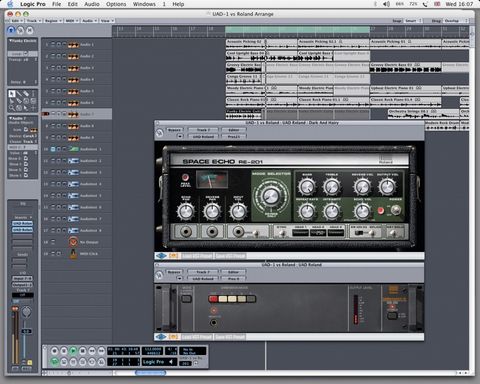Thanks to the software tie-up between universal audio we can welcome the Dimension D stereo chorus and spatial effects box into the lineup for Universal Audio's UAD-1 PCI card plug-in system. It joins its fellow Roland legends - the Boss CE-1 and the RE-201 Space Echo stereo chorus as the Roland Classic Series FX bundle.
Designed as a stereo chorus rack unit, the Dimension D's real charm lay in the spatial effect it had on any signal run through it, subtly enhancing it and giving it another, er, dimension. Yep, hence the name.
The Dimension D really is a one-trick pony. There are four variations on a theme (stereo chorus) and that's it. If you like to indulge in endless tweaking, the Dimension D's control panel probably seems disappointingly spartan. However, if you want subtle spatial enhancement of your recordings without a side order of in-your-face chorus effect, this is the perfect plug-in for the job.
First impressions
The Dimension D takes simplicity to a Fisher Price level. There are five, fat coloured buttons that make it work - four Dimension Modes, increasing in intensity from buttons one to four, and an Off button. Guess what that one does?
Universal Audio sensibly moved the Stereo/Mono switch from the back of the unit to the front, there's a Power switch on the far right and an Output level meter before that, but otherwise, there's nothing more than a whole lot of empty space on the Dimension D's front panel.
In use
By default, the plug-in loads with the Stereo Mode on, so you'll need to check this according to your source. In Mono mode, the Dimension D is defiantly monophonic, so even stereo inputs are summed to mono. It's a useful option to have for sonic variation, though, such as when using the plug-in on an auxiliary bus.
In fact, this was our preferred use for it, as you can then dial in varying degrees of dimension. It may only have four buttons, but the Dimension D can also be operated in multi-button mode for subtle combinations of the sounds - hold Shift as you click each one. The supplied presets automatically offer all the possible combinations, so it's worth checking them out.
After switching the buttons around for a while, you quickly get used to the natural sound of the effect. This also means you notice immediately when it's switched off, as the sound seems to shrink back into itself.
There's a hint of reverb and EQ about the Dimension D's sound and it really suits acoustic sources, like guitars, pianos, woodwind and vocals.
The soundstage becomes a little wider, a little airier at the edges, this effect being more noticeable with mono tracks in Mono mode. One of the nice things about the Dimension D is that it never seems to lard on too much chorus - again, using it as a send effect helps control this.
Conclusion
The Dimension D doesn't really do all that much and it's hard to get people excited about a plug-in whose main strength is its subtlety. True, sonic mangling is not the Dimension D's forté, but it is a cool tool to have in your arsenal to give lacklustre tracks a subtle lift or give acoustic and vocal recordings extra air and space. If it's spatial enhancement you're after, you won't find many better alternatives.


